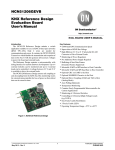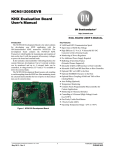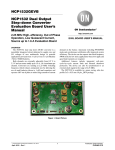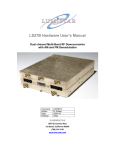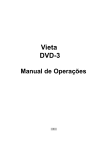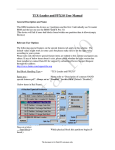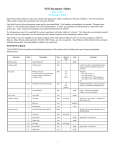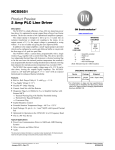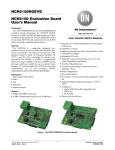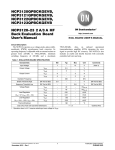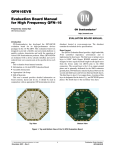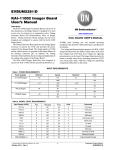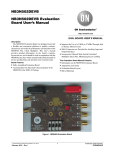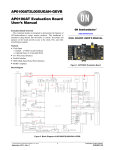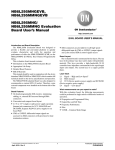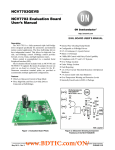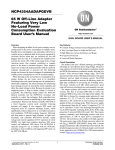Download EVBUM2338 - NCN51XX10GEVB Evaluation Board User`s Manual
Transcript
NCN511010GEVB, NCN512010GEVB, NCN512110GEVB, NCN513010GEVB NCN51XX10GEVB Evaluation Board User'sManual www.onsemi.com EVAL BOARD USER’S MANUAL • • • • Introduction The NCN51XX10GEVB Evaluation Board is the ideal solution for developing your KNX application with an ON Semiconductor KNX transceiver. The evaluation board contains the KNX transceiver which handles the transmission and reception of data on the bus. It will also generate all necessary voltages to power the board and external loads. The NCN51XX10GEVB Evaluation Board assures safe coupling to and decoupling from the KNX bus. Bus monitoring warns the external microcontroller for loss of power so that critical data can be stored in time. • • • • • • • • Features • 9,600 baud KNX Communication Speed • Supervision of KNX Bus Voltage • High Efficient 1.2 V to 21 V Selectable DC−DC Converter to Drive External Loads Monitoring of Power Regulators No Additional Power Supply Required Buffering of Sent Data Frames (Extended Frames Supported) Selectable UART or SPI Interface to Host Controller Selectable UART and SPI Baud Rate to Host Controller Optional CRC on UART to the Host Optional MARKER Character to the Host Optional Direct Coupling of RxD and TxD to Host (Analog Mode) Auto Polling (Optional) Temperature Monitoring Operating Temperature Range of −40°C to +105°C Figure 1.The NCN51XX10GEVB Evaluation Board © Semiconductor Components Industries, LLC, 2015 November, 2015 − Rev. 0 1 Publication Order Number: EVBUM2338/D NCN511010GEVB, NCN512010GEVB, NCN512110GEVB, NCN513010GEVB NCN51XX Description Table 1. CONNECTOR DESCRIPTION OF THE NCN51XX10GEVB BOARD The NCN51XX10GEVB provides an evaluation board for ON Semiconductor KNX transceivers that can be easily connected to a prototype design. Table 1 lists the available connectors on this board. Connector Description J4 KNX Bus Connection J2 Interface Connector J1 Interface Connector (alternate) Electrical Characteristics Operating ranges define the limits for functional operation and parametric characteristics of the evaluation board. Note that the functionality of the evaluation board outside these operating ranges is not guaranteed. Operating outside the recommended operating ranges for extended periods of time may affect device reliability. Table 2. OPERATING RANGES Symbol Parameter Min Max Units +20 +33 V VBUS Voltage on positive pin of J4 (Note 1) VDIG Voltage on J1 (Pins 7, 8, 12, 13, 15−22) and J2 (Pins 7, 8, 11, 14−22) 0 +3.3 V VANA Output Voltage on J1 (Pin 6) or J2 (Pin 5) 0 +3.3 V VDD1 Output Voltage on J1 (Pin 24) or J2 (Pin 23) 0 +3.3 V VDD2 Output Voltage on J1 (Pin 2) or J2 (Pin 1) (Note 2) 0 +21 V V20V Output Voltage on J1 (Pin 4) or J2 (Pin 3) 0 +22 V Ta Ambient Temperature −40 +105 °C 1. Voltage indicates DC value. With equalization and active pulse, bus voltage must be between 11 V and 45 V 2. See Adjustable DC*DC Converter page 7 for the limitations! www.onsemi.com 2 Figure 2.Schematic of NCN51XX10NGEVB D C B A Mounting Hole Mounting Hole Mounting Hole Fiducial Round Fiducial Square 1 C11 100 nF D4 SS16T3G D1 C10 1 uF C12 10 uF V2 1 2 3 C6 4 5 47 nF 6 7 C8 8 9 220 nF V20V 10 27 Ohm 100 uF C9 J5 R5 100 nF C4 ON Logo (silkscreen, 5,5mm) R10 39k R7 120k Garbage Logo (metal layer, 5,5mm) Pb−Free Logo (metal layer, 5,5mm) ESD Logo (silkscreen, 4mm) 2 XTAL1 10 pF VSSA VBUS2 TXO CCP CAV VBUS1 CEQ1 CEQ2 VFILT V20V U1 10k 0r 3.3V R4 R3 CE Logo (metal layer, 5mm) Ground Bar R1 Fiducial Round J4 KNX+ KNX− 2 x 13.14.125 243−211 J3 1SMA40CAT3G 16 MHz C1 X1 As close as possible to U1 C2 10 pF XTAL2 VDDD SCK/UC2 SDO/TXD SDI/RXD CSB/UC1 TREQ MODE2 MODE1 TRIG XCLKC C13 10 uF 3.3V NCN5130 30 29 28 27 26 25 24 23 22 21 CSB TREQ MODE2 DNP MODE1 TRIG XCLKC SCK TXD C3 100 nF 3.3V C7 2 Next text on top silkscreen: NCN51xx Evaluation Board Next text on bottom copper layer: NCN51XX_V10_REV2 1 Ohm R8 1 40 39 ANAOUT 38 37 RESETB 36 SAVEB 35 XTAL1 34 XTAL2 33 32 XCLK 31 VDDA ANAOUT FANL RESET SAVE XTAL1 XTAL2 XSEL XCLK VSSD VDD2MV VDD2MC VDD2 VSS2 VSW2 VIN VSW1 VSS1 VDD1 VDD1M 11 12 13 14 15 16 17 18 19 20 3 220 uH L1 220 uH L2 1 Ohm www.onsemi.com R9 All components (except D1 and D4) as close as possible to U1. D1 and D4 as close as possible to J4. R6 DNP R2 RXD 3.3V TXD RXD CSB TREQ MODE2 MODE1 TRIG XCLKC XCLK SCK ANAOUT RESETB SAVEB V20V V2 SCK RXD TXD TREQ CSB MODE1 MODE2 XCLKC TRIG 3.3V XCLK SAVEB RESETB ANAOUT V20V V2 613 024 211 21 J1 1 2 3 4 5 6 7 8 9 10 11 12 13 14 15 16 17 18 19 20 21 22 23 24 4 613 024 210 21 J2 1 2 3 4 5 6 7 8 9 10 11 12 13 14 15 16 17 18 19 20 21 22 23 24 C B A D Variant = Variant name not interpreted Cannot open Property of ON Semiconductor, All Rights Reserved file C:\Users\ffx3 File:C:\projects\knxb\doc\1_Application\hw\3_Develop\REV10\NCN51xx_Daughterboard.SchDoc qc\Document Name:Tom De Ryck Date:27/10/2015 Sheet1 of 1 s\My_Standa Rev: 2 3 4 D3 0 Ohm NSR0520V2 D2 NSR0520V2 3 NCN511010GEVB, NCN512010GEVB, NCN512110GEVB, NCN513010GEVB NCN51XX10NGEVB Description Schematic Diagram − BOM List − PCB Layout NCN511010GEVB, NCN512010GEVB, NCN512110GEVB, NCN513010GEVB Table 3. NCN51XX10NGEVB BILL OF MATERIALS Designator Qty Value (NCN5110) Description Value (NCN5120) Value (NCN5121) C1, C2 2 Multilayer Ceramic, COG, 50 V, ±0, 5 pF, 0402 DNP C3, C4, C11 3 Multilayer Ceramic, X7R, 10 V, ±10%, 0402 100 nF C6 1 Multilayer Ceramic, X7R, 50 V, ±10%, 0603 47 nF Value (NCN5130) 10 pF C7 DNP C8 1 Multilayer Ceramic, X7R, 50 V, ±10%, 0603 220 nF 4.7 nF 220 nF C9 1 SMD Electrolytic Capacitor, 35 V, ±20%, 8x10 C10 1 Multilayer Ceramic, X7R, 35 V, ±10%, 0603 1 mF C12, C13 2 Multilayer Ceramic, X7R, 25 V, ±20%, 1206 10 mF D1 1 1 A Schottky Rectifier, SMA D4 1 400 Watt SMA Transient Voltage Suppressor, 40 V Bidirectional, SMA J2 1 WR−PHD Angled Pin Header, Dual Row, 24 Pins, 2,54 mm Pitch J3 1 EIB (KNX) Bus Coupler Unit Connector, Dark Grey and Red J4 1 EIB (KNX) Bus Coupler Unit Pins, 8,5 mm Length, 5,75 mm pitch L1, L2 2 WE−PD2SR SMD Shielded Power Inductor, 7,5x8,0 220 mH R1 1 Shorting Link, Pitch 10.16 mm, Height 9 mm, Not−Isolated 0r Thick Film Resistor, 100 mW, ±5%, 0603 0r 100 mF SS16T3G D2, D3 DNP R2 1SMA40CAT3G Wurth Elektronik 613 024 210 21 Wago 243−211 Ettinger 13.14.125 R3 1 Thick Film Resistor, 100 mW, ±5%, 0603 0r DNP 0r R4 1 Thick Film Resistor, 100 mW, ±1%, 0603 10k DNP 10k R5 1 Thick Film Resistor, 1 W, ±5%, 2512 27r 22r 27r R7 1 Thick Film Resistor, 100 mW, ±5%, 0603 120k 33k 120k R6 DNP R8, R9 2 Thick Film Resistor, 100 mW, ±1%, 0603 1r R10 1 Thick Film Resistor, 100 mW, ±5%, 0603 U1 1 ON Semiconductor KNX Transceiver, NQFP−40 X1 1 Crystal, SMD, 4 Pins, 3,2 x 2,5 mm 39k 180k NCN5110 NCN5120 DNP www.onsemi.com 4 39k NCN5121 16 MHz NCN5130 NCN511010GEVB, NCN512010GEVB, NCN512110GEVB, NCN513010GEVB Figure 3.Top Layer Layout Figure 4.Bottom Layer Layout www.onsemi.com 5 NCN511010GEVB, NCN512010GEVB, NCN512110GEVB, NCN513010GEVB Figure 5.PCB Dimensions General Overview is foreseen (mandatory) as also a Transient Voltage Suppressor (D2, Figure 2). Minimum VBUS is 20 V (see KNX standard). IBUS is limited by the transceiver, as well as the rate of change of IBUS. This limitation is required by the KNX standard. If the FANIN pin is open, IBUS can maximum be 12 mA and change at 0.5 mA/ms. If the FANIN pin is shorted to ground, IBUS can maximum be 24 mA and change at 1 mA/ms. For NCN5110 and NCN5130, the FANIN pin can also have a resistance to ground to set the current limit to any value between 6mA and 47 mA, with an associated current slope limitation of 0.23 mA/ms to 1.95 mA/ms. Because the NCN5120 Development Board contains a KNX Certified KNX Transceiver no further details on KNX will be given in this document. Detailed information on the ON Semiconductor Certified KNX Transceivers can be found in the NCN5110/NCN5120/NCN5121/NCN5130 datasheets (www.onsemi.com). Detailed information on the KNX Bus can be found on the KNX website and in the KNX standards (www.knx.org). KNX Bus Connection Connection to the KNX bus is done by means of J4. A standard Wago connector (type 243*211) can be used for this (see Figure 6). A reverse protection diode (D1, Figure 2) Figure 6.KNX Bus Connector www.onsemi.com 6 NCN511010GEVB, NCN512010GEVB, NCN512110GEVB, NCN513010GEVB Power Supplies The DC value of the VFILT line should be higher than VDD2. Although VDD2 is capable of delivering 100 mA, the maximum current capability will not always be usable. One needs to make sure that the KNX bus power consumption stays within the KNX specification. The KNX transceiver provides the power from the bus for the complete application. The evaluation board will provide the following voltages to the application. VFILT This is an unregulated voltage resulting on a buffer capacitance, after observing the bus current (slope) limits. All other voltages are derived from this voltage. If the application has sharp load transients on any voltage rail, enough buffer capacitance must be placed on VFILT. See the datasheet for more information. Crystal Oscillator A crystal of 16 MHz (X1, see Figure 11) is foreseen on the development board. This clock signal is also supplied to the microcontroller. As the clock signal is only used for digital services, the NCN5110 does not require a crystal. See the datasheet (www.onsemi.com) for more details on this block. V20V: This is a linear regulated +20 V. Since this voltage is derived from VFILT, it may be that this voltage is lower than 20 V when the bus voltage is low or when during a load transient VFILT drops below 20 V. For more information on this rail and the current limit, see the datasheet. Interface The device can communicate with the host controller by means of a UART interface or an SPI interface. The selection of the interface and communication speed is done by the pins MODE1, MODE2, TREQ, SCK/UC2 and CSB/UC1 which can be pulled up or down, or connected to the microcontroller. More details on the different interfaces can be found in the datasheet. +3V3 A +3V3 is provided from one DCDC convertor. This voltage is also used as the supply for the transceiver. Although VDD2 is capable of delivering 100 mA, the maximum current capability will not always be usable. One needs to make sure that the KNX bus power consumption stays within the KNX specification. Monitoring RESETB and SAVEB The KNX transceiver controls the reset state of the microcontroller by means of the RESETB signal. An additional SAVEB signal can be monitored by the microcontroller to detect possible issues. See datasheet for more details on these two signals. VDD2 This is a second power supply which can be used to drive external loads. The voltage is programmable between 1.2 V (NCN5110/NCN5121/NCN5130) or 3.3 V (NCN5120) and 21 V by means of an external resistor divider (R7 and R10, see Figure 2). The voltage divider can be calculated as follows for NCN5120: R7 + R 10 R VDD2M R 10 ) R VDD2M Voltage Supervisors On Semiconductor KNX transceivers have different voltage supervisors, which can be read out through registers. Please check the datasheet for more details. V DD2*3.3 3.3 Temperature Monitor The transceiver produces an over−temperature warning (TW) and a thermal shutdown warning (TSD) , which can be read out through resistors. Please check the datasheet for more details. RVDD2M is between 60 k and 140 k (typical 100 k). The voltage divider can be calculated as follows for NCN5110/NCN5121/NCN5130: R 7 + R 10 V DD2*1.2 1.2 www.onsemi.com 7 NCN511010GEVB, NCN512010GEVB, NCN512110GEVB, NCN513010GEVB FAQ 4. Can we request ON Semiconductor to supply the higher layer stacks? By no means will ON Semiconductor provide any higher layer stacks. Certified higher layer stacks can be provided by 3rd party companies. 5. How much load can the outputs drive? The maximum allow load can be calculated with the formula as given in Adjustable DC−DC Converter (page x13). IDD2 defines the maximum load the outputs can drive in total. 6. Is it possible to test all interfaces (UART, SPI, Analog Mode) with this evaluation board? Yes, the board can be used with all possible interfaces. One has to be careful however when using the Analog Mode. In the Analog Mode the digital of NCN5120 is bypassed. If the microcontroller would force the RXD*pin (pin 29) high, the transceiver would pull the KNX bus low continuously, which could lead to issues. 7. I’m having issues with the voltage regulators whenever I’m going above a certain current. What could be the issue? To be able to take more than 13 mA from the KNX bus one needs to pull the FANIN *pin of NCN5120 low. This can be done by shorting J5 (add jumper). See datasheet for more info on the FANIN *pin. Additionally, there is a current limit on V20/3V3/VDD2 1. Is this development board KNX Certified? No, only the transceiver is KNX Certified. The development board may only be used for evaluation of the transceiver. It is not allowed to use the development board in a final product or to sell it as a KNX Certified product. Contact ON Semiconductor if you want to use the development board as a final product. 2. What 3rd party companies do you recommend for the higher layer stacks? ON Semiconductor does not recommend any 3rd party company in particular. Several 3rd party companies have KNX Certified stacks and it’s always advised to use one of these stacks. Some companies have experience with ON Semiconductor KNX transceivers. Contact ON Semiconductor for more information. 3. Can we freely reuse the schematic and layout of this development board? It is allowed to reuse the schematic, components and layout of the evaluation board for your own application. Because the operating conditions of your design are not known by ON Semiconductor, one must always fully verify the design even if it’s based on this evaluation board. Contact ON Semiconductor if additional information is required. ON Semiconductor and the are registered trademarks of Semiconductor Components Industries, LLC (SCILLC) or its subsidiaries in the United States and/or other countries. SCILLC owns the rights to a number of patents, trademarks, copyrights, trade secrets, and other intellectual property. A listing of SCILLC’s product/patent coverage may be accessed at www.onsemi.com/site/pdf/Patent−Marking.pdf. SCILLC reserves the right to make changes without further notice to any products herein. SCILLC makes no warranty, representation or guarantee regarding the suitability of its products for any particular purpose, nor does SCILLC assume any liability arising out of the application or use of any product or circuit, and specifically disclaims any and all liability, including without limitation special, consequential or incidental damages. “Typical” parameters which may be provided in SCILLC data sheets and/or specifications can and do vary in different applications and actual performance may vary over time. All operating parameters, including “Typicals” must be validated for each customer application by customer’s technical experts. SCILLC does not convey any license under its patent rights nor the rights of others. SCILLC products are not designed, intended, or authorized for use as components in systems intended for surgical implant into the body, or other applications intended to support or sustain life, or for any other application in which the failure of the SCILLC product could create a situation where personal injury or death may occur. Should Buyer purchase or use SCILLC products for any such unintended or unauthorized application, Buyer shall indemnify and hold SCILLC and its officers, employees, subsidiaries, affiliates, and distributors harmless against all claims, costs, damages, and expenses, and reasonable attorney fees arising out of, directly or indirectly, any claim of personal injury or death associated with such unintended or unauthorized use, even if such claim alleges that SCILLC was negligent regarding the design or manufacture of the part. SCILLC is an Equal Opportunity/Affirmative Action Employer. This literature is subject to all applicable copyright laws and is not for resale in any manner. PUBLICATION ORDERING INFORMATION LITERATURE FULFILLMENT: Literature Distribution Center for ON Semiconductor 19521 E. 32nd Pkwy, Aurora, Colorado 80011 USA Phone: 303−675−2175 or 800−344−3860 Toll Free USA/Canada Fax: 303−675−2176 or 800−344−3867 Toll Free USA/Canada Email: [email protected] N. American Technical Support: 800−282−9855 Toll Free USA/Canada Europe, Middle East and Africa Technical Support: Phone: 421 33 790 2910 Japan Customer Focus Center Phone: 81−3−5817−1050 www.onsemi.com 8 ON Semiconductor Website: www.onsemi.com Order Literature: http://www.onsemi.com/orderlit For additional information, please contact your local Sales Representative EVBUM2338/D








